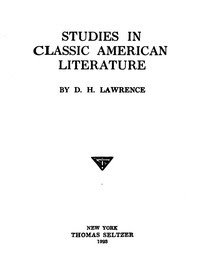STUDIES IN CLASSIC AMERICAN LITERATURE
BY
D. H. LAWRENCE
NEW YORK
THOMAS SELTZER
1923
CONTENTS
FOREWORD
I. THE SPIRIT OF PLACE
II. BENJAMIN FRANKLIN
III. HECTOR ST. JOHN DE CRÈVECŒUR
IV. FENIMORE COOPER'S WHITE NOVELS
V. FENIMORE COOPER'S LEATHERSTOCKING NOVELS
VI. EDGAR ALLAN POE
VII. NATHANIEL HAWTHORNE AND "THE SCARLET LETTER"
VIII. HAWTHORNE'S "BLITHEDALE ROMANCE"
IX. DANA'S "TWO YEARS BEFORE THE MAST"
X. HERMAN MELVILLE'S "TYPEE" AND "OMOO"
XI. HERMAN MELVILLE'S "MOBY DICK"
XII. WHITMAN
FOREWORD
Listen to the States asserting: "The hour has struck! Americans shall be American. The U.S.A. is now grown up artistically. It is time we ceased to hang on to the skirts of Europe, or to behave like schoolboys let loose from European schoolmasters—"
All right, Americans, let's see you set about it. Go on then, let the precious cat out of the bag. If you're sure he's in.
Et interrogatum ab omnibus:
"Ubi est ille Toad-in-the-Hole?"
Et iteratum est ab omnibus:
"Non est inventus!"
Is he or isn't he inventus?
If he is, of course, he must be somewhere inside you, Oh American. No good chasing him over all the old continents, of course. But equally no good asserting him merely. Where is this new bird called the true American? Show us the homunculus of the new era. Go on, show us him. Because all that is visible to the naked European eye, in America, is a sort of recreant European. We want to see this missing link of the next era.
Well, we still don't get him. So the only thing to do is to have a look for him under the American bushes. The old American literature, to start with.
"The old American literature! Franklin, Cooper, Hawthorne & Co.? All that mass of words! all so unreal!" cries the live American.
Heaven knows what we mean by reality. Telephone, tinned meat, Charlie Chaplin, water-taps, and World-Salvation, presumably. Some insisting on the plumbing, and some on saving the world: these being the two great American specialties. Why not? Only, what about the young homunculus of the new era, meanwhile? You can't save yourself before you are born.
Look at me trying to be midwife to the unborn homunculus!
Two bodies of modern literature seem to me to have come to a real verge: the Russian and the American. Let us leave aside the more brittle bits of French or Marinetti or Irish production, which are perhaps over the verge. Russian and American. And by American I do not mean Sherwood Anderson, who is so Russian. I mean the old people, little thin volumes of Hawthorne, Poe, Dana, Melville, Whitman. These seem to me to have reached a verge, as the more voluminous Tolstoi, Dostoevsky, Chekhov, Artzibashev reached a limit on the other side. The furthest frenzies of French modernism or futurism have not yet reached the pitch of extreme consciousness that Poe, Melville, Hawthorne, Whitman reached. The European moderns are all trying to be extreme. The great Americans I mention just were it. Which is why the world has funked them, and funks them to-day.
The great difference between the extreme Russians and the extreme American lies in the fact that the Russians are explicit and hate eloquence and symbols, seeing in these only subterfuge, whereas the Americans refuse everything explicit and always put up a sort of double meaning. They revel in subterfuge. They prefer their truth safely swaddled in an ark of bulrushes, and deposited among the reeds until some friendly Egyptian princess comes to rescue the babe.
Well, it's high time now that someone came to lift out the swaddled infant of truth that America spawned some time back. The child must be getting pretty thin, from neglect.
The PDF might take a minute to load. Or, click to download PDF.
If your Web browser is not configured to display PDF files. No worries, just click here to download the PDF file.



No comments:
Post a Comment